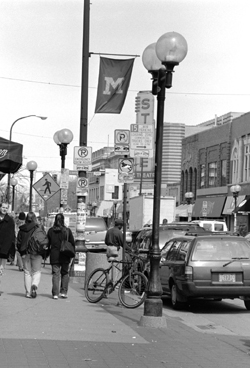By Rebecca A. Doyle

A recommendation is expected to be before Ann Arbor City Council in late September or early October that could change not only the way parts of Central Campus look, but how you get there.
Based on recommendations developed by the College of Architecture and Urban Planning, the School of Public Policy and the Business School, Ann Arbor’s Downtown Development Authority is taking a hard look at the State Street area to understand how best to redesign its traffic flow, resources and physical characteristics. The State Street area is defined as the area loosely bounded by Huron, William, Thayer and Division streets, but it also includes the Rackham Building, Power Center for the Performing Arts and immediate vicinity.
One of the most visible changes is the proposed conversion from one-way to two-way traffic on portions of State, Liberty, Maynard, Thompson and North University streets.
Susan Pollay, executive director of the Downtown Development Authority (DDA), worked with the city to commission a study of the impact such traffic changes would have. The results of the study, completed by Tetra Tech and presented by Jeff Heald at a public meeting Aug. 17, revealed that two-way traffic on those streets, while it would certainly slow some of the traffic flow, could achieve some of the objectives of area merchants. During discussion, several participants pointed out that the end sought by the State Street Association was not to pass traffic through as quickly as possible, but to think of the area as a destination for shoppers, cultural event audiences and diners.
“Two-way streets would not reduce any of the traffic congestion,” Pollay says, “but the area would feel more accessible,” an asset that would benefit both the U-M and retailers.
Returning the area to two-way traffic would necessitate removal of approximately 20 parking meters in the area and a study of traffic light use for pedestrian traffic. Other projects the DDA plans include reduction of signage in the area and more use of landscaping.
Pollay says the proposal is slated to go before Ann Arbor City Council either in late September or early October. Douglas S. Kelbaugh, dean of the College of Architecture and Urban Planning and a member of the audience at the public presentation, said that he hoped Council would take advantage of the opportunity to speak with Walter Kulash, a noted traffic expert who takes a holistic approach to traffic management “instead of thinking of travel as a means to get from point A to point B.” Pollay said she thought the Council would not make a decision immediately, and that public input would be welcome when the proposal was delivered.

